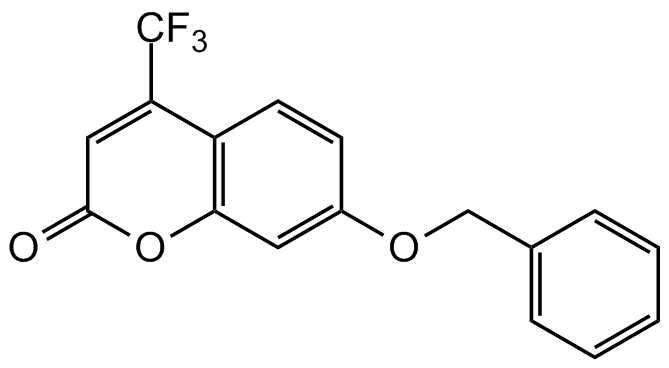7-Benzyloxy-4-trifluoromethycoumarin
| Code | Size | Price |
|---|
| CDX-B0299-M050 | 50 mg | £255.00 |
Quantity:
| CDX-B0299-M250 | 250 mg | £743.00 |
Quantity:
Prices exclude any Taxes / VAT
Overview
Regulatory Status: RUO
Shipping:
AMBIENT
Storage:
Short Term: +20°C, Long Term: -20°C
Images
Documents
Further Information
Alternate Names/Synonyms:
BFC
Appearance:
White to off-white powder.
CAS:
220001-53-6
EClass:
32160000
Form (Short):
liquid
GHS Symbol:
GHS07
Handling Advice:
Protect from light and moisture.
Hazards:
H302 + H312 + H332
InChi:
InChI=1S/C17H11F3O3/c18-17(19,20)14-9-16(21)23-15-8-12(6-7-13(14)15)22-10-11-4-2-1-3-5-11/h1-9H,10H2
InChiKey:
WVKLERKKJXUPIK-UHFFFAOYSA-N
Long Description:
Chemical. CAS: 220001-53-6. Formula: C17H11F3O3. MW: 320.3. 7-Benzyloxy-4-trifluoromethylcoumarin is a fluorescent substrate for cytochrome P450 family members CYP1A2, CYP3A4 and potentially others. Has been used in high-throughput screens in fluorometric p450 activity assays and is metabolized to the fluorescent metabolite 7-Hydroxy-4-trifluoromethylcoumarin (HFC) with lambdaex=410nm; lambdaem=530nm.
MDL:
MFCD01564466
Molecular Formula:
C17H11F3O3
Molecular Weight:
320.3
Package Type:
Vial
Precautions:
P280, P301 + P312 + P330, P302 + P352 + P312, P304 + P340 + P312
Product Description:
7-Benzyloxy-4-trifluoromethylcoumarin is a fluorescent substrate for cytochrome P450 family members CYP1A2, CYP3A4 and potentially others. Has been used in high-throughput screens in fluorometric p450 activity assays and is metabolized to the fluorescent metabolite 7-Hydroxy-4-trifluoromethylcoumarin (HFC) with lambdaex=410nm; lambdaem=530nm.
Purity:
>97% (NMR)
Signal word:
Warning
SMILES:
O=C1C=C(C(F)(F)F)C2=C(C=C(OCC3=CC=CC=C3)C=C2)O1
Solubility Chemicals:
Soluble in DMSO.
Source / Host:
Synthetic.
Transportation:
Non-hazardous
UNSPSC Category:
Biochemical Reagents
UNSPSC Number:
12352200
Use & Stability:
Stable for at least 2 years after receipt when stored at -20°C.
References
(1) A.B. Renwick, et al.; Xenobiotica 30, 955 (2000) | (2) A.B. Renwick, et al.; Xenobiotica 31, 861 (2001) | (3) K.K. Khan & J.R. Halpert; Chem. Res. Toxicol. 15, 806 (2002) | (4) V. Zlabek & G. Zamaratskaia; Animal 6, 633 (2012) | (5) Y.T. Ung, et al.; High-Throughput 7, 29 (2018) (Review) | (6) H. Raunio, et al.; Int. J. Mol. Sci. 21, 4708 (2020) (Review)



